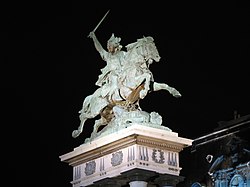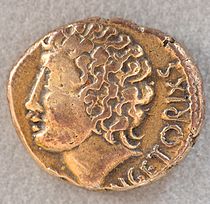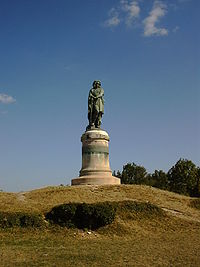Vercingetorix

Vercingetorix (IPA: [werkiŋˈɡetoriks] in Latin), born around 82 BC, died 46 BC, was chieftain of the Arverni, originating from the Arvernian city of Gergovia and known as the man who led the Gauls in their ultimately unsuccessful war against Roman rule under Julius Caesar. Known primarily through Caesar's accounts, Vercingetorix's revolt is frequently used as a heroic example of Gallic virtue and resolve.
History
Having been appointed governor of the Roman province of Gallia Narbonensis (modern Provence) in 58 BC, Julius Caesar proceeded to conquer the Gallic tribes beyond over the next few years, maintaining control through a careful divide and rule strategy. He made use of the factionalism among the Gallic elites, favouring certain noblemen over others with political support and Roman luxuries such as wine. Attempts at revolt, such as that of Ambiorix in 54 BC, had secured only local support, but Vercingetorix, whose father, Celtillus, had been put to death by his own countrymen for seeking to rule all of Gaul, managed to unify the Gallic tribes against the Romans and adopted more modern styles of warfare.
The revolt that Vercingetorix came to lead began in early 52 BC while Caesar was raising troops in Cisalpine Gaul. Believing that Caesar would be distracted by the turmoil in Rome following the death of Clodius, the Carnutes, under Cotuatus and Conetodunus, made the first move, slaughtering the Romans who had settled in their territory.
Vercingetorix, a young nobleman of the Arvernian city of Gergovia, roused his dependents to join the revolt, but he and his followers were expelled by the nobles of the city, including Vercingetorix's uncle Gobanitio, because they thought opposing Caesar too great a risk. Undeterred, Vercingetorix raised an army of the poor, took Gergovia and was hailed as king.[1] He made alliances with other tribes, and having been unanimously given supreme command of their armies, imposed his authority through harsh discipline and the taking of hostages. He adopted the policy of retreating to natural fortifications, and undertook an early example of a scorched earth strategy by burning towns to prevent the Roman legions from living off the land.
Vercingetorix and his army won some initial minor engagements with the Romans units led by Caesar and his chief lieutenant Titus Labienus. However, the Romans captured the capital of the Bituriges, Avaricum (Bourges), killing the entire population of 120,000. The next major battle was at Gergovia, where Vercingetorix defeated Caesar, inflicting heavy losses. However, the victory cost Vercingetorix many men, including many noblemen. Due to these losses he retreated and moved to another stronghold, Alesia.

In the Battle of Alesia Caesar built a fortification around the city to besiege it. However, Caesar's army was surrounded by the rest of Gaul, and Vercingetorix had summoned his Gallic allies to attack the besieging Romans, so Caesar built another outer fortification against the expected relief armies (resulting in a doughnut-shaped fortification). The relief came in insufficient numbers: estimates range from 80,000 to 250,000 soldiers. Vercingetorix, the tactical leader, was cut off from them on the inside, and without his guidance the attacks were initially unsuccessful. However, the attacks did reveal a weak point in the fortifications and the combined forces on the inside and the outside almost made a breakthrough. Only when Caesar personally led the last reserves into battle did he finally manage to prevail. This was a decisive battle in the creation of the Roman empire.
According to legend Vercingetorix surrendered in magnificent fashion, allegedly riding his horse out of Alesia and around Caesar's camp before throwing his arms at Caesar's feet, stripping himself of his armor and kneeling to Caesar with a flourish.[2] Caesar provides a first-hand contradiction of this account, describing Vercingetorix's surrender much more modestly.[3] He was imprisoned in the Tullianum in Rome for five years, before being publicly displayed in Caesar's triumph in 46 BC. He was executed after the triumph, probably by strangulation in his prison, as ancient custom would have it.[4]
Etymology
The etymology of the name Vercingetorix is conjectural.
It can be analysed as Gaulish ver- ("over, superior" - an etymological cognate of Latin super or Greek hyper),[5] cingeto- ("warrior", related to roots meaning "tread, step, walk", so possibly "infantry"),[6] rix ("king").[7]
Alternately, the name can be translated as "leader of the high council", with Gaulish ver and rix as above, but combined with "cyngat" (compare to Welsh "harmony", and here meaning an entity that makes decisions by consensus or harmony, rather than by fiat).[original research?]
Both translations are consistent with modern understanding of Gaulish custom and language, and with the Gaulish reaction to overwhelming Roman military power. However, absent additional information, neither translation should be considered authoritative.
Memorial

Napoleon III erected a seven metre statue of Vercingétorix in 1865 , created by the sculptor Aimé Millet, on the supposed site of Alesia. The architect for the memorial was Viollet-le-Duc.[8] The impressive statue still stands. The inscription on the base, written by Viollet-le-Duc, reads (in French):
- « La Gaule unie
- Formant une seule nation
- Animée d'un même esprit,
- Peut défier l'Univers. »
Which translates to:
- « United Gaul
- Forming a single nation
- Animated by a same spirit,
- Can defy the Universe. »
There is a statue of Vercingétorix by Bartholdi on Place de Jaude in Clermont-Ferrand (see first image).
In France, Vercingétorix is often considered a folk hero.
Popular culture

- Vercingetorix appears in the Asterix series of comics, notably in Asterix and the Chieftain's Shield and Asterix the Gaul. He is seen at his surrender to Caesar, throwing his arms on (rather than at) Caesar's feet causing him to hobble, rather than walk, to his next conquest.
- Vercingetorix appears in the third yearbook of the Marvel GI Joe comics, a short story titled "My Dinner with Serpentor" dealing with his surrender due to the origins of pizza.
- Vercingetorix appears in the Alix comics series, notably in the album entitled Vercingetorix.
- Vercingetorix is one of the Great Generals appearing in Civilization IV.
- A 2001 French film, Vercingétorix, also known as Vercingétorix: la légende du druide roi ("Vercingetorix: the legend of the druid king"), released as Druids in English, was directed by Jacques Dorfmann and co-written by Dorfmann and Norman Spinrad, starring Christopher Lambert in the title role. It was neither a critical nor a box-office success, but did far better in Europe than the United States of America. Spinrad went on to write a novel, The Druid King, released in 2003.
- Vercingetorix appeared in the 2002 TNT television miniseries Julius Caesar, played by Heino Ferch.
- Vercingetorix's campaign against Caesar is the subject of Morgan Llywelyn's 1992 novel Druids.
- The "Prince of all the Gauls" appears in the 2005 HBO/BBC series Rome, played by Giovanni Calcagno. He is in the episodes "The Stolen Eagle" and "Triumph."
- Vercingetorix appears as an enemy character in the computer games Praetorians and Age Of Empires.
- Rix, a shortened form of Vercingetorix, was the name of Dominique San Juste's horse in Michele Hauf's novel, Seraphim
- In 62: A Model Kit, a novel by Julio Cortazar, a lead character sculpts a statue of Vercingetorix holding under his arm, as the charactere describes it, "his own decapitated head enlarged by history, changed into two thousand years of schoolboy compositions and the pretext for hollow speeches..."
- Vercingetorix appears as a French warrior in the Anachronism card game.
- Vercingetorix appears in the novel "Emperor: The field of swords" - a Novel of Julius Caesar, by Conn Iggulden.
- Vercingetorix appears in the novel ‘The Triumph of Caesar’, by Steven Saylor ISBN 978-1-84529-567-7
References
Primary sources
- Julius Caesar, Commentarii de Bello Gallico Book 7
- Dio Cassius, Roman History 40:33-41, 43:19
- Plutarch, Life of Caesar 25-27
Secondary sources
- Yonge, Charlotte M. (1864), "The Chief of the Arverni", in Charlotte M. Yonge, A Book of Golden Deeds, London: Blackie & Son, Ltd., n.d.
- Popular comic strip by Goscinny & Uderzo's [Asterix][1] the Gaul.
Notes
- ^ Julius Caesar, Commentaries on the Gallic War Book VII, sect. 4.
- ^ Plutarch's Lives, Everyman's Edition, 1910, reprinted 1953, (Dryden translation), vol. ii, page 551. Medieval French Historians are also partly responsible for romanticising Vercingetorix's surrender. Romancing the Past: The Rise of Vernacular Prose Historiography in Thirteenth-Century France, by Gabrielle M. Spiegel, page 143, Berkeley: 1993.
- ^ Commentaries on the Gallic Wars, Everyman's Edition, 1953 (Trans: John Warrington); Book VII, sect. 89.
- ^ Birkhan, Die Kelten (1997) p. 238.
- ^ Proto-Celtic: *wor, An etymological lexicon of Proto-Celtic
- ^ Proto-Celtic: *kengeto-, An etymological lexicon of Proto-Celtic
- ^ Proto-Celtic: *r–g-, An etymological lexicon of Proto-Celtic
- ^ Statue of Vercingetorix, Art and Architecture, 2006
External links
- A reconstructed portrait of Vercingetorix, based on historical sources, in a contemporary style.
- Curchin, Leonard A. Lingua Gallica (The Gaulish Language). Retrieved Aug. 21, 2003 from http://www.classics.uwaterloo.ca/labyrinth/gallica.htm
- Vercingétorix at IMDb
- Paul Marius Martin, Vercingétorix : le politique, le stratège. Paris : Perrin, 2000, 260 p. ISBN 2262016917
